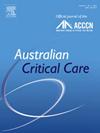Acid–base imbalances in critically ill obstetric patients: A multicentre retrospective cohort study
IF 2.7
3区 医学
Q2 CRITICAL CARE MEDICINE
引用次数: 0
Abstract
Background
Acid–base imbalances are critical indicators of clinical outcomes in intensive care settings, yet their specific impact on critically ill pregnant obstetric patients remains underexplored. This lack of knowledge is particularly concerning given the potential for severe outcomes in this vulnerable population.
Aim/objective
The aim of this study was to assess acid–base abnormalities and their association with severe outcomes, including mortality.
Methods
We conducted a retrospective multicentre cohort study between 2006 and 2019 across six high-complexity hospitals in Colombia (two obstetric centres and four general hospitals with intensive care units that admit obstetric patients). Arterial blood gas was evaluated for acid–base balance at admission, and its association with clinical outcomes, including maternal death, mechanical ventilation, and vasopressor use, was assessed.
Results
The study included 798 patients: 768 survivors and 30 nonsurvivors. Our findings revealed that respiratory alkalosis was the most common imbalance (491/798 [61.5%]). Its presence is linked to better survival rates. Conversely, mixed metabolic and respiratory acidosis significantly increased the risk of mortality (18/768 [2.3%] in survivors vs. 7/30 [23.3%] in nonsurvivors, p < 0.001). After adjusting for confounders, lower potential hydrogen (pH) and bicarbonate (HCO3) levels were associated with higher in-hospital mortality.
Conclusions
Most critically ill obstetric patients presented with baseline respiratory alkalosis, and the inability to maintain it was strongly associated with increased mortality. Further controlled studies are needed to confirm these findings and explore the impact of interventions to sustain respiratory alkalosis on outcomes.
危重产科患者的酸碱失衡:一项多中心回顾性队列研究
酸碱失衡是重症监护环境中临床结果的关键指标,但其对危重孕妇产科患者的具体影响仍未得到充分探讨。鉴于这一弱势群体可能面临严重后果,这种知识的缺乏尤其令人担忧。目的/目的本研究的目的是评估酸碱异常及其与严重后果(包括死亡率)的关系。方法:我们在2006年至2019年期间对哥伦比亚六家高复杂性医院(两家产科中心和四家设有产科患者重症监护病房的综合医院)进行了一项回顾性多中心队列研究。入院时评估动脉血气的酸碱平衡,并评估其与临床结果的关系,包括产妇死亡、机械通气和血管加压药的使用。结果共纳入798例患者:768例幸存者和30例非幸存者。结果显示,呼吸性碱中毒是最常见的失衡(491/798[61.5%])。它的存在与更高的存活率有关。相反,混合性代谢性和呼吸性酸中毒显著增加了幸存者的死亡风险(18/768 [2.3%]vs.非幸存者的7/30 [23.3%]),p <;0.001)。在调整混杂因素后,较低的潜在氢(pH)和碳酸氢盐(HCO3)水平与较高的住院死亡率相关。结论大多数危重产科患者均出现呼吸性碱中毒,且无法维持与死亡率升高密切相关。需要进一步的对照研究来证实这些发现,并探讨维持呼吸性碱中毒的干预措施对结果的影响。
本文章由计算机程序翻译,如有差异,请以英文原文为准。
求助全文
约1分钟内获得全文
求助全文
来源期刊

Australian Critical Care
NURSING-NURSING
CiteScore
4.90
自引率
9.10%
发文量
148
审稿时长
>12 weeks
期刊介绍:
Australian Critical Care is the official journal of the Australian College of Critical Care Nurses (ACCCN). It is a bi-monthly peer-reviewed journal, providing clinically relevant research, reviews and articles of interest to the critical care community. Australian Critical Care publishes peer-reviewed scholarly papers that report research findings, research-based reviews, discussion papers and commentaries which are of interest to an international readership of critical care practitioners, educators, administrators and researchers. Interprofessional articles are welcomed.
 求助内容:
求助内容: 应助结果提醒方式:
应助结果提醒方式:


